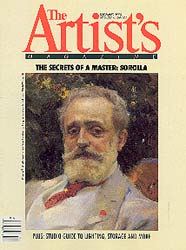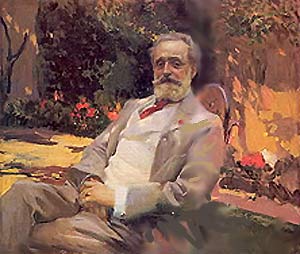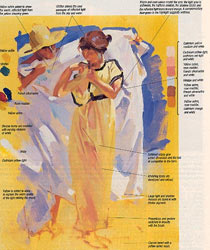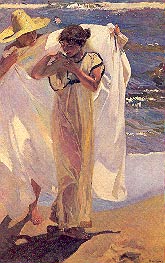Light and Color, Sorolla Style
By Charles Sovek
The Artist's Magazine - December, 1990 (Cover Story)
How to use the full range of values and brilliant hues to capture the dazzling look of light.
 Few artists in any period of history have exploited the effects of light as impressively as Joaquin Sorolla. Sunsplashed beach scenes, dramatically lit interiors and a daring approach to outdoor portraiture made him one of the most important painters of the century. Equally skilled at capturing both the tonal and color essence of a subject, Sorolla dedicated his life to chasing the sun as it played over the people and places of his beloved Spain. He continues to inspire students and professionals alike. Few artists in any period of history have exploited the effects of light as impressively as Joaquin Sorolla. Sunsplashed beach scenes, dramatically lit interiors and a daring approach to outdoor portraiture made him one of the most important painters of the century. Equally skilled at capturing both the tonal and color essence of a subject, Sorolla dedicated his life to chasing the sun as it played over the people and places of his beloved Spain. He continues to inspire students and professionals alike.
DIFFERENT SIDES OF SOROLLA
Sorolla first earned fame with his portraits. These were solid, convincing pictures, yet they lacked a vibrant use of color. With a palette of earth colors, similar to that of Velasquez, his pictures appeared brown and "old masterly."
Soon, however, he discarded black, umbers and siennas in favor of pinks, purples and oranges, and he began developing and completing his paintings outdoors. At the height of his powers during this "rainbow" period, Sorolla didn't hesitate to tackle even the most complex subjects with the confidence of a master. Children bathing against a sparkling ocean, picnic scenes full of frolicking figures, townspeople mending nets and so on were all inspiration during this fertile period. Careful tonal modeling was replaced by stacatto-like slashes of various color notes. His normally playful brushwork took on even more vitality, and his desire to catch a fleeting effect replaced his earlier passion for carefully defining a form.
|
Using Outdoor Light
Constantly on the lookout for fresh ways of handling the figure, Sorolla often painted portraits outdoors. In Raimundo de Madraza in his Paris Garden (37 1/2 x 44; right) he turned what could have been a typical academic indoor work Into an animated representation of the sitter. Notice the soft but telling patches of dappled sunlight on Me shoulders, chest and right arm and how they echo a similar theme In the background. Also observe how the cool blue of the sky defines the lights of the form.
|
 |
Whether employing two platoons of models working in shifts as he painted a 7 X 10 foot composition with a crew of assistants shielding his canvas from the sun with sheets or squatting under a tree with a 9 x 12-inch portable sketchbox, Sorolla was a painter obsessed with light.
THE MASTER’S PALATTE
Varying with the subjects he painted, Sorolla used essentially two different color palettes. For studio portraits, he favored one that included black, burnt umber, raw umber, rose madder, burnt sienna, raw sienna, yellow ochre, Naples yellow, vermilion and cobalt blue. Occasionally he would add orange, pink or purple, but he usually emphasized strong tonal contrasts over ambitious color effects. His outdoor palette was completely different and included cobalt violet, rose madder, all the cadmium reds, cadmium orange, all the cadmium yellows, yellow ochre, chrome green (since replaced by permanent green light), viridian, Prussian blue, cobalt blue and French ultramarine. In both cases, he used lead white.
A teacher I had in art school, who once saw Sorolla give a demonstration, said he worked on a palette as big as a dining room table, squeezed out all the color from the tubes, and laid in the painting with brushes that had handles three feet long!
JUGGLING TONE, LIGHT AND COLOR
Whether working outdoors in sunlight or painting from a window or lamp-lit interior, Sorolla kept reasonably close to the age-old axiom that every object in light should be painted a middle-gray value or above, and every object in shadow a middle-gray value or below. And a study of his work bears this out.
Observe the value distribution in Beach of Valencia by Morning Light (Page 2), and notice how even the dark striping on the hulls of the boats is raised to a middle-gray value in light. Correspondingly, the shadows of the white clothing of the women bending over in the foreground, which is the lightest area in shadow, is painted no lighter than a middle-gray value.
Another device the artist used was to keep a consistent bracket of values between light and shadow. Be it the white clouds in the left background, the middle-value figures lying on the beach or the dark hulls of the boats, Sorolla maintained a consistent, two-value jump between light and shadow on every object in the composition.
Another contributing factor to Sorolla's masterly control of values is his treatment of halftones. Because of the glaring effect of the sun, the halftones are only slightly darker in value than the passages of light. If painted a deeper value, these modeling tones would assume an importance inconsistent with the subject's strong light and shadow pattern and thereby neutralize the raking feeling of light in the picture.
|
|
Crisp, Reflected Lights
Sorolla loved to point white objects, and in After the Bath (68 1/2 x 43 1/2; at left) we see him reveling in myriad reflected lights and colors displayed when cloth is struck with sunlight. Notice how the yellow from the woman's dress melts into the white drape held by the boy in a hat, and how the lavender-gray of the shadow is intensified by the addition of the complementary color. You can also see how the darker value of the water next to the top of the drape makes the white appear even crisper. Another quality that makes this painting successful is the feeling of wetness in the water and on the clinging dress of the figure. Sorolla gave dimension to the composition with the simple indication of the three small figures bathing in the distant surf.
|
|
Handling the Hues - When working outdoors, Sorolla changed his palette completely from the darker, earthier one he used indoors. This demonstration (right) shows how he created ambitious color effects with his palette of the cadmium reds, yellows and orange, plus cobalt violet, rose madder, yellow ochre, chrome green (permanent green light on today's palette), viridian, Prussian blue, cobalt blue, French ultramarine and lead white. Note the array of warm and cool colors used to model the forms and reveal the play of light.
|
 Click for larger image - 140KB
Click for larger image - 140KB
(Opens in new window)
|
Vermeer and Rembrandt used light as a foundation for their compositions while Monet was the first painter to capitalize on the color of light and its corresponding effects in shadow. But instead of continuing to use both a full range of values and a full spectrum of colors -as he did so successfully when executing his Argentuil paintings in the 1870s - Monet chose to pitch his values ever lighter until his pictures resembled a fabric of shimmering, high-key colors. Sorolla, on the other hand, invariably used both a full tonal range and striking color schemes.
The use of contrasting color temperature is another hallmark of Sorolla's work. In all of the paintings shown here, either the light is warm and the shadow cool or the light is cool and the shadows warm, as in the figure in Raimundo de Madrazo in his Paris Garden (top of page). This not only snares the unique quality of a lighting effect but also gives the paintings a colorful vitality. It was no accident that the white towel in After the Bath (above) is bluish in shadow and yellowish in light. So too with the fleshtones, clothing, sand and water.
|

![]()
 Few artists in any period of history have exploited the effects of light as impressively as Joaquin Sorolla. Sunsplashed beach scenes, dramatically lit interiors and a daring approach to outdoor portraiture made him one of the most important painters of the century. Equally skilled at capturing both the tonal and color essence of a subject, Sorolla dedicated his life to chasing the sun as it played over the people and places of his beloved Spain. He continues to inspire students and professionals alike.
Few artists in any period of history have exploited the effects of light as impressively as Joaquin Sorolla. Sunsplashed beach scenes, dramatically lit interiors and a daring approach to outdoor portraiture made him one of the most important painters of the century. Equally skilled at capturing both the tonal and color essence of a subject, Sorolla dedicated his life to chasing the sun as it played over the people and places of his beloved Spain. He continues to inspire students and professionals alike.

